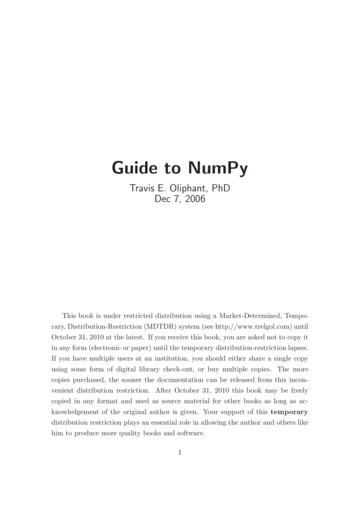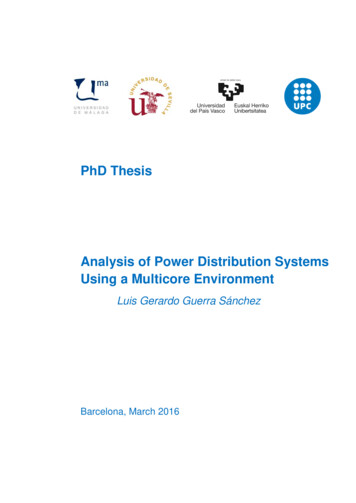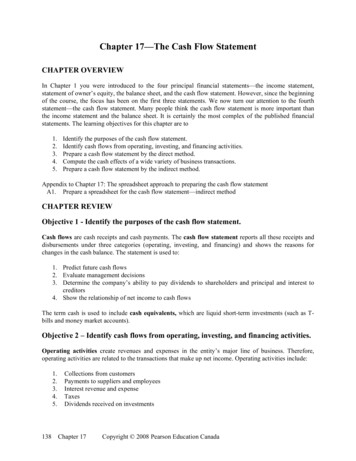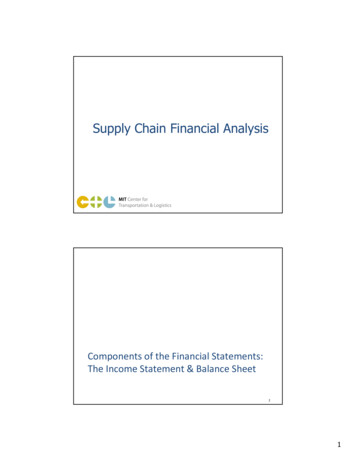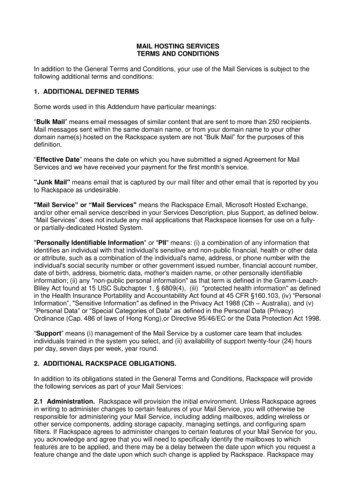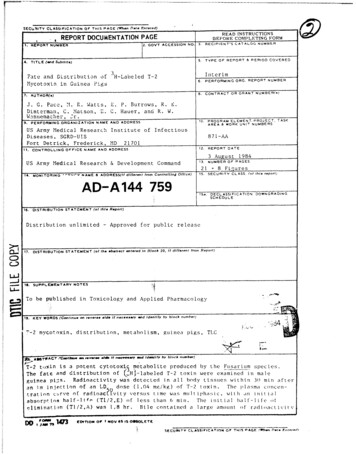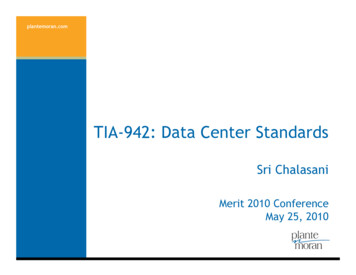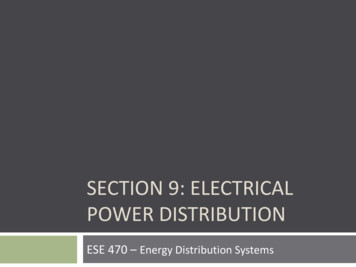
Transcription
CECW-OMDepartment of the ArmyEP 1130-2-510U.S. Army Corps of EngineersPamphlet No.1130-2-510Washington, DC 20314-1000Project OperationsHYDROELECTRIC POWER OPERATIONS ANDMAINTENANCE GUIDANCE ANDPRODCEDURESDistribution Restriction StatementApproved for public release; distribution is unlimited.13 Dec 96
DEPARTMENT OF THE ARMYU.S. Army Corps of EngineersWashington, D.C. 20314-1000CECW-OMPamphletNo. 1130-2-510EP 1130-2-51013 December 1996Project OperationsHYDROELECTRIC POWER OPERATIONS AND MAINTENANCEGUIDANCE AND PROCEDURESTABLE OF CONTENTSParagraphPageCHAPTER 1 - 1-11-21-31-41-11-11-11-1CHAPTER 2 - Reports on Hydroelectric Power Generation Statistics And Operating PTER 3 - Coordination of Hydroelectric Power Operations With Power Marketing AgenciesReserved.CHAPTER 4 - Project Employee Refresher Operational Exercises For Emergency Stations,Multiple-purpose Projects With PowerReserved.CHAPTER 5 - Hydroelectric Power Plant TraineesPurposeRationaleSelection of TraineesEmployment ProvisionsTraining ResponsibilitiesTraining SitesProgram DetailsTraining Program ScheduleTraining EvaluationFailure to Maintain SatisfactoryProgressTraining -15-15-25-35-35-45-45-105-115-55-5
EP 1130-2-51013 Dec 96ParagraphTraining RecordsCertificate of CompletionTraining at the Journeyman Level5-125-135-14Page5-55-55-5CHAPTER 6 - Rewind of Hydroelectric Generators And Generator PPENDIX A - Congressional Report FormatA-1APPENDIX B - Rate ComputationB-1APPENDIX C - Generating Equipment Service Summary (ENG Form 4338 E)C-1APPENDIX D - MSC Summary Report Format For Hydropower GenerationD-1APPENDIX E - Equipment Failure And System Disturbance Telephone ReportE-1APPENDIX F - Monthly Power Plant (DOE Form EIA-759) ReportF-1APPENDIX G - Training Program ScheduleG-1APPENDIX H - Training AccomplishmentsH-1APPENDIX I - Training RecordsI-1APPENDIX J - Certificate of Training (DA Form 87)J-1APPENDIX K - Background InformationK-1APPENDIX L- Evaluation ItemsL-1APPENDIX M - Economic Analysis GuidanceM-1APPENDIX N - Additional Technical ReferencesN-1ii
EP 1130-2-51013 Dec 96CHAPTER 1 - INTRODUCTION1-1. Purpose. This pamphlet establishes the guidance for the operation and maintenance (O&M)of USACE hydroelectric power generation facilities and related structures at civil works waterresource projects and supplements Engineer Regulation (ER) 1130-2-510.1-2. Applicability. This guidance applies to all USACE commands having responsibility for civilworks functions and hydroelectric power generation.1-3. References.a. PL 85-507, The Government Employees Training Act, 7 July 1958.b. PL 95-91, Section 302, 95th Congress, Department of Energy Organization Act, 4August 1977 (91 Stat. 565).c. PL 99-662, Section 937, Reports on Hydropower Statistics, Water ResourcesDevelopment Act of 1986.d. PL 104-303, Section 216, Water Resources Development Act of 1996.e. PL 534, Section 5, 78th Congress, Flood Control Act of 1944, 22 December 1944, (58Stat. 889).d. AR 690-400, Employee Performance and Utilization, Chapters 410, 430 and 432.e. USACE Supplement 1 to AR 690-400, 410 and 430, Employment Performance andUtilization Training.f. ER 385-1-31, Safety Clearance Proceduresg. ER 1105-2-100, Guidance for Conducting Civil Works Planning Studies.h. ER 1110-2-109, Hydroelectric Design Center.i. ER 1110-2-1200, Plans and Specifications.j. ER 1130-2-500, Partners in Support (Work Management Policies).k. ER 1130-2-510, Hydroelectric Power Operations and Maintenance Policies.l. REMR Condition Rating Procedures/Condition Indicator For Hydropower Equipment.1-4. Glossary.a. Allocated Power Investment Cost. That portion of total project investment cost whichis allocated to generation of power based on firm cost allocation of multipurpose projects withpower.1-1
EP 1130-2-51013 Dec 96b. Available Hours. The hours during which a unit is available. Available Hours (AH) isequal to the sum of Service Hours (SH) plus Reserve Standby Hours (RSH).c. Balance of Total Investment Cost. The cumulative unpaid federal investment in powerfacilities. The cost includes the additional federal investments subsequent to the initial placementof generating units in service and the credits for the revenues transferred to the project.d. Delayed Forced Outage Hours (DFOH). The hours for any malfunction that results inremoval of a generating unit from connection to the transmission system for maintenance or repairat a later time, so as to allow an outage to be scheduled after the trouble develops.e. Equipment Failures and Generation Interruptions. For the purpose of this guidance,equipment failures and generation interruptions are defined as those affecting the project's majorpower plant equipment which are necessary for generation of hydroelectric power. Suchequipment may consist of turbines, generators, transformers, switching equipment, station servicesystem, etc. Also included in this definition is loss of power generation due to project operatingprocedures and errors, improper or faulty maintenance or work practices. Interruptions due tolightning strikes, outages of non-USACE facilities, and those where impact to service, equipment,cost, etc. is insignificant are excluded.f. Forced Outage Hours (FOH). The hours for any failure, misoperation, or malfunctionthat results in the immediate automatic or manual removal of a generating unit from connection tothe transmission system, or that prevents such connection from being accomplished when desired.g. Generator Forced Outage (GFO). Any generating unit forced outage caused by amisoperation, failure or malfunction of a turbine, water passage, governor, or generator, includingrelated auxiliaries or controls. These items are considered to represent a generating unit.h. Generator Scheduled Outage (GSO). A scheduled outage for a generating unit. (See1-4.g. above and Note 1 below.)i. Hours. Hours will be recorded to the nearest hundredth.j. In-Service Date. The in-service time and date reported in compliance with ER 1130-2510, Chapter 2, Reports on Hydroelectric Power Generation Statistics.k. Non-Generator Forced Outage (NGFO). A forced outage caused by misoperation,failure or malfunction of equipment or facilities beyond the load side of the generator terminals.l. Non-Generator Scheduled Outage (NGSO). A scheduled outage for equipment otherthan a generating unit. (See 4-4.l. above and Note 1 below.)m. Period Hours (PH). The number of hours in the year for existing units. For new units,the hours since the unit was first synchronized until the end of the year.n. Planned Modification Hours (PMH). Scheduled outage for installation of newequipment, switchyard rearrangements or to correct design or construction deficiencies.1-2
EP 1130-2-51013 Dec 96Replacement of existing equipment due to failure or normal deterioration is not included. (SeeNote 1 below.)o. Reserve Standby Hours (RSH). The hours during which a generating unit is not inservice, but is available for use if required.p. Service Hours (SH). The hours during which a generating unit is connected to thetransmission system either supplying power or condensing; i.e., the time during which thegenerator main power circuit breaker is closed.q. Scheduled Outage Hours (SOH). The hours for routine repetitive maintenance andrepair that have been programmed into the power schedule.NOTE 1: When a variety of work is performed on both generating unit and non-generatingequipment, the primary reason for the outage will determine to which category the outage hourswill be charged. Outages due to reservoir conditions, high tailwaters, flood control operations,loss of transmission lines, or short outages for trash removal are not to be considered unavailabletime.1-3
EP 1130-2-51013 Dec 96CHAPTER 2 - REPORTS ON HYDROELECTRIC POWER GENERATION STATISTICS2-1. Purpose. This chapter establishes guidance for reporting USACE hydroelectric powerstatistics, including the availability, failure and usage rates of generating equipment; powergenerating equipment failures and generation interruptions; monthly power plant generation; andin-service data at multiple-purpose projects having hydroelectric power.2-2. Background.a. This pamphlet provides guidance for implementing the following hydropower statisticaland informational reporting requirements to Congress and other designated recipients, as definedin ER 1130-2-510, Chapter 2, Reports on Hydroelectric Power Generation Statistics, and forcoordinating the operation of the Corps of Engineers hydroelectric generating facilities with thepower marketing agencies. Reporting requirements include:(1) general hydroelectric power generation equipment operational and cost data;(2) the availability, failure and usage rates of generating equipment at multiple-purposeprojects having hydroelectric power;(3) power generating equipment failures and generation interruptions; and(4) the in-service dates for hydroelectric generating units and reporting the monthlypower plant generation on the Department of Energy Form EIA-759.b. Section 5 of the Act of December 22, 1944 (PL 534, 78th Congress) provides thatelectric power and energy generated at reservoir projects under the control of the Department ofthe Army and in the opinion of the Secretary of the Army not required in the operation of suchprojects shall be delivered to the Secretary of Interior for transmittal and disposal in a manner toencourage the most widespread use thereof at the lowest possible rates to consumers consistentwith sound business principles.c. Section 302 of the Department of Energy Organization Act (PL 95-91) transfer allfunctions of the Secretary of Interior under Section 5 of the 1944 Act to the Secretary of Energytogether with all other functions of the Secretary of Interior, and officers and components of theDepartment of the Interior, with respect to Southeastern Power Administration; the SouthwesternPower Administration; the Alaska Power Administration; the Bonneville Power Administration;Western Area Power Administration; and the power marketing functions of the Bureau ofReclamation.2-3. Guidance.a. Congressional Reports. Section 937, Reports on Hydropower Statistics, PL 99-662,Water Resources Development Act of 1986, states that the Secretary of the Army shall provide tothe Committee on Public Works and Transportation of the House of Representatives and theCommittee on Environment and Public Works of the Senate, a statistical report on each waterresources project constructed by the Army Corps of Engineers which generates electricity. (SeeAppendix A.)2-1
EP 1130-2-51013 Dec 96(1) The report shall specify:(a) Amount of electricity generated;(b) Revenues received by the United States from the sale of electricity;(c) Costs of construction, operation, and maintenance allocated to power; and(d) Balance owed to the US Treasury by the Power Marketing Administration.(2) Submission Dates. The report is due to the Congress by the 15th of January each year.The field operating activities will submit to CECW-OM their data by 15 December each year.b. Service Rates for Generating Equipment.(1) Each year, on a fiscal year basis, districts having multi-purpose projects withhydropower will determine and report the rates listed below for each hydroelectric project. Theserates will be composite for each project, based on the total main unit hours in each category for allunits at the project, and computed as indicated in Appendix B.&In-service operating rate.&Generator scheduled outage rate.&Standby rate.&&Non-generator scheduled outagerate.Availability rate.&&Planned modification outage rate.Generator forced outage rate.&Non-generator forced outage rate.&Non-generator delayed forced outagerate.&Generator delayed forced outagerate.(2) Service Rate Reports.(a) Each MSC shall furnish annual reports to HQUSACE (CECW-OM) by 15 February(RCS CECW-0-34) for the previous fiscal year utilizing the Lotus 1-2-3 format provided as ENGForm 4338-E (AUG 89), illustrated in Appendix C. The reports shall be submitted using adiskette or electronic mail.(b) The additional information shown in Appendix D shall be furnished as a MSCsummary report along with an individual summary report for each district having hydroelectricpower facilities.c. Equipment Failure and Generation Interruption Reports.(1) Project Managers shall report all power generating equipment failures and generationinterruptions anticipated to cost in excess of 50,000, or require more than five working days toreturn equipment to service, to CECW-OM immediately by telephone, facsimile machine (FAX),2-2
EP 1130-2-51013 Dec 96or electronic mail (E-mail) and then also in writing. Reports shall be made as soon as possible;however, reports must be furnished before the end of the next regular business day. A sample ofthe required information is provided as Appendix E.(2) When requested by CECW-OM, a detailed narrative report shall be prepared andforwarded to CECW-OM as soon as all pertinent information and data on the failure orinterruption are available. The report shall present the information and data in such a manner asto facilitate review and evaluation by CECW-OM and other elements of the HQUSACE. Thesereports are required for review and evaluation for determining what changes are needed in guidespecifications, operating and maintenance procedures, or personnel training, to reduce powerproduction interruptions.(3) Written Report. When requested, a detailed narrative report will be prepared andforwarded to CECW-OM as soon as all pertinent information and data on the failure orinterruption are available. The report will include, but not be limited to, the following informationas applicable: Name of the project; actual time of day and date of occurrence; identity ofequipment or procedure causing the interruption; unit(s) involved; megawatts of projectgeneration shutdown; megawatts of load passing through the project switchyard beforeinterruption; megawatts of switchyard load interrupted; actual or estimated length of timerequired to return the failed equipment to service; the actual cause of failure or interruption; andany deficiencies found in design, construction, operation or maintenance. The report will alsoinclude a description of all actions, interim and final, needed to restore equipment to service, andrecommendations for changes in design, construction, protective equipment, operational andmaintenance practices and procedures that will reduce the possibility of recurrence. Supportingdata, such as single line diagrams, sketches, schematic wiring diagrams, and photographs will beincluded when such information will clarify the cause of the interruption and assist in determiningthe best corrective action. The report will present the information and data in such a manner as tofacilitate review and evaluation by CECW-OM and other elements of the HQUSACE.d. Monthly Power Plant (DOE FORM EIA-759) and In-Service Data Reports forHydroelectric Generating Units.(1) The Commander, U.S. Army Corps of Engineers (USACE) is required to keep theChairman, Federal Energy Regulatory Commission, informed of the current installed hydroelectricgenerating capacity at USACE projects.(a) This includes installation of new generators and changes in the existing generatingcapacity due to rewinding of the generator stator, or any other reason. Within five business dayafter occurrence of the in-service date, the Commander, USACE, will be notified, Attention:CECW-OM, of the name of the project and the nameplate rating in kilowatts of each unit as it isplaced in service. The information may be transmitted by telecopy, electronic mail or any othersuitable method. The in-service date of a unit is defined as the date when the generator is firstbrought to rated terminal voltage and synchronized to the transmission system.(b) For new generators, the date when the generator is initially placed in service, asdefined above. For existing generators, the date is when the generator is again placed inoperation after a change in capacity. Units declared in service, which subsequently developtrouble requiring modifications that may delay normal generation, will continue to be consideredin service, unless otherwise specifically approved by the Commander, USACE. The in-service2-3
EP 1130-2-51013 Dec 96date information will agree with the date reported to the Power Marketing Administration andFederal Energy Regulatory Commission.(c) In service data, for stator rewinds, turbine replacements, or similar work that does notchange the nameplate rating of the unit, will be reported only to CECW-OM.(2) Monthly power Plant Report - Form EIA-759 (OMB No. 1905-0129 and RCSFERC-1001). Each month Energy Information Administration (EIA) of the Department ofEnergy furnishes USACE field offices with copies of Form EIA-759 for the monthly generationreport. This form shall be completed and submitted directly to EIA by the tenth of the followingmonth. In determining net generation, the power used for operation of locks, fishways, floodcontrol, or functions other than power will be included. Power for the operation of thepowerhouse and generating equipment only will be deducted from gross generation in computingnet generation. A copy of completed Form EIA-759 will be forwarded to CECW-OM forinformation concurrent with sending the original to the Energy Information Administration. Asample copy of this form is provided as Appendix F.e. Reports for Power Marketing Agencies.(1) The Corps is responsible for operating the hydroelectric projects and providinginformation affecting cost and availability of power to the Power Marketing Agencies. Marketingthe power declared excess to the need of the projects and recovering Federal investment are theresponsibilities of the Power Marketing Agencies.(2) Specific Requirements.(a) Continuing. Prompt written notification will be provided to the appropriate powermarketing agency each time a change in power operation or condition which could substantiallyaffect costs or power availability is anticipated.(b) Annually, when no changes in power operations or costs are expected for thesucceeding 12 month period, the marketing agency will be notified of that fact in writing.(3) MSC Responsibility. The MSCs directly responsible for communicating with themarketing agency will develop reporting procedures in coordination with that agency. Thisresponsibility may be delegated to the District Commander.2-4
EP 1130-2-51013 Dec 96CHAPTER 3 - COORDINATION OF HYDROELECTRIC POWER OPERATIONS WITH POWERMARKETING AGENCIESReserved.3-1
EP 1130-2-51013 Dec 96CHAPTER 4 - PROJECT EMPLOYEE REFRESHER OPERATIONAL EXERCISES FOREMERGENCY STATIONS, MULTIPLE-PURPOSE PROJECTS WITH POWERReserved.4-1
EP 1130-2-51013 Dec 96CHAPTER 5 - HYDROELECTRIC POWER PLANT TRAINEES5-1. Purpose. This chapter establishes the procedures for the Corps of Engineers apprenticeshiptraining program for hydropower trainees for advancement to journeyman status as power plantoperators, mechanics, electricians, or electronic mechanics. Guidance for establishing trainingbeyond the apprenticeship program is also included.5-2. Rationale. Hydroelectric power plants are complex electrical and mechanical installationswhich need trained personnel for operation and maintenance. The trend towards automation andoptimization further emphasizes the importance of a well trained staff to ensure continuity andreliability of power generation. Sufficient number of qualified personnel are not available from theindustry to meet the Corps requirements and this necessitates a training program to developtrainees to perform well at journeyman level.5-3. Selection of Trainees. The vacancies will be filled from any appropriate source, e.g., OPMregister, merit promotion action, reassignments, change to lower grade, Veterans' ReadjustmentAct, Handicap authority, etc. Single-Agency Qualification Standard for Hydroelectric PowerPlant Trainee (Army) has been issued by the U.S. Civil Service Commission. Physicalrequirements are included in the above standard. All candidates, including current Federalemployees, must meet these standards. Human Resources will prepare a list of eligible candidatesfor selection by the MSC Commander or his/her designate.5-4. Employment Provisions.a. Trainee Agreement. Each trainee will enter into a written agreement with the localappointing authority. The agreement will specify, but not be limited to:(1) Local arrangements about tools and supplies.(2) Trainee's employment and training in an occupation, under standards adequate toproduce a qualified skilled worker.(3) Conditions for advancement and retention, removal from the program, andperformance in a full performance position.(4) Mobility during and after training for Division-wide placement.(5) Mandatory service for four years after graduating from the program, otherwise thetrainee must reimburse Government expenses on pro-rate basis.b. Probationary Period. The probationary period for a trainee is one year. However,unacceptable performance during the program period will be a cause to remove him from thetraining program under 5 USC 4303.c. Pay During Training. Pay rates for trainee levels are established by the Department ofDefense Wage Fixing Authority and are shown on current authorized wage schedules. CurrentFederal employees who enter the training program will have their pay set in accordance with theOPM regulations.5-1
EP 1130-2-51013 Dec 965-5. Training Responsibilities.a. Headquarters, U.S. Army Corps of Engineers. The Headquarters (CECW-OM) shallbe responsible for overview of the training program and keeping the ER current to meet thechanging requirements. Any deviations from the program will require approval from CECW-OM.b. Major Subordinate Command. The MSC Commander is responsible for the overallimplementation and management of the program. At his/her discretion, the MSC Commandermay delegate all or part of his/her duties to the district commanders as appropriate.c. District. The District Commander, when so delegated, is responsible for theimplementation of the training program. The Chief, Operations Division will see that the trainingis imparted as stipulated in this EP. He/she will also be an advisor to the District Commander onmatters pertaining to the training program.d. Training Board. A training board shall be established at the MSC or District level, asdetermined by the MSC Commander. The Board shall consist of a minimum of three members.The Chairman and each Board member shall be directly involved in, and knowledgeable of,operation and maintenance of Corps hydroelectric power plants. The Board shall be responsiblefor:(1) Reviewing trainees' requests for reduction in training time and forwarding them to theMSC Commander or his delegatee for approval or denial.(2) Reviewing and approving course instructions and on-the-job training for traineesgranted a reduction in training time.(3) Evaluating progress of classroom instructions and on-the-job performance of eachtrainee at the end of each training phase.(4) Recommending to the MSC commander the hydroelectric power plants to be used astraining sites.(5) Other training related duties as assigned.e. Training Facility.(1) Training Coordinator. The Chief, Operations Division, in each district withhydropower training site(s) shall appoint a training coordinator at each training site. The trainingcoordinator will be responsible for scheduling classroom and on-the-job training for all assignedtrainees. He/she will also provide assistance and guidance to instructors, as needed, and beresponsible for maintaining training records.(2) Senior Craft-person. The senior craft-person to whom the trainee is assigned for onthe-job training will be responsible to over-see the trainee's work assignments. The senior willmake every effort to ensure that the trainee receives the best possible training, and will guide,monitor and evaluate the trainee's work and progress on a daily basis. The senior will alsoprovide to the training coordinator a formal evaluation of the trainee at the completion of trainee'srotational assignment with the senior's crew.5-2
EP 1130-2-51013 Dec 96(3) Instructors. The instructors, or project personnel acting in this capacity, will beresponsible for providing classroom instructions to the trainees. They should have thedemonstrated capability to teach the class and have been at least a senior level craft-person. Theinstructors are responsible for keeping the training coordinator appraised of the trainee'sperformance, and for keeping trainees informed of their progress in the classroom.(4) Trainees. The trainees are responsible for meeting and maintaining standards ofFederal employment in their class-room and on-the-job performance and personal work conduct.They are responsible for learning the study material and be able to do the work required in thetrade without hazard to themselves or other workers.5-6. Training Sites. The MSC Commander will select the hydroelectric power projects to beused as training sites. They should be chosen from the larger and more complex projects in theMSC. If feasible, trainees should be transferred between projects while in the training program tobroaden their experience.5-7. Program Details. The training program will consist of a combination of academic, plantequipment study, and on-the-job training. The academic training will be imparted by enrolling in acorrespondence school for academic subjects and class room (or equivalent) instructions for plantequipment. On-the-job training will be achieved by orderly progression through practicalassignments closely related to correspondence school subjects and plant equipment instructions.a. Training Period. A four-year training and development program will be required for allentrants who do not have previous hands on experience, and academic or vocational educationbeyond the entry level requirements.b. Reduced Training Period. Reductions in time required to complete the trainingprogram may be granted by the MSC Commander for the prior experience or training, providedthat the trainee applies for such reduction before completing the first year of the standardprogram. The trainee will be responsible for providing the satisfactory proof of experience ortraining he or she cites as creditable for a reduction in training time. Acceptable proof will beacademic transcripts and course descriptions from accredited vocational schools, colleges orcommunity colleges, and statements from former supervisors outlining previous workexperiences, level of responsibility, and performance appraisal. Only one reduction will begranted. If the MSC Commander grants a trainee a reduction in time of the training period, thetraining coordinator shall prepare a training schedule which will insure that the trainee has anopportunity to develop the same skills and knowledge by the end of the reduced training period asa full four year program trainee would have. This training schedule must be approved by thetraining board. Trainees granted a reduction in training time will have their progress evaluated inthe same manner as a full 4-year term trainee.c. Craft Selection. The first one year of the training program will be identical for allcrafts. Specialization will begin in the second year. Each trainee will be asked to express apreference for the craft specialty desired. Depending on the needs of power plants and trainee'saptitude and talents, the training board will assign a craft specialty, subject to the approval by theMSC commander, to each trainee before the beginning of the specialization phase. The trainingboard will document the basis on which assignment was based.d. Deviation from the Standard Program. Any deviation from the standard four yearprogram as stated herein, or material changes in classroom subjects, shall be submitted to5-3
EP 1130-2-51013 Dec 96HQUSACE, ATTN.: CECW-OM for approval. No such changes shall be incorporated withoutprior approval of HQUSACE.5-8. Training Program Schedule.a. General. The first year of the training program consists of approximately 60% on-thejob training at a Corps hydroelectric power project, and 40% training in trade theory and closelyrelated academic subjects. The next three years of the program consists of approximately 80%on-the-job training at a Corps hydroelectric power plant, and 20% training in trade theory andclosely related academic subjects.b. Academic Instructions. Craft persons are required to know the basic physicalprinciples of the equipment they use. They are also required to read and understand reasonablycomplex written instructions, and be able to write legible, meaningful reports. Instructions inacademic subjects should preferably be provided by professional teachers. This could beaccomplished through a local school system if it is located nearby and is easily accessible. Ifprofessional classroom training is not practical because of geographic distance, thencorrespondence courses (Appendix G) or other delivery methods covering the same generalsubjects should be provided to the trainees.c. Plant Equipment Study. The plant equipment study is designed to provide a traineewith the theory and operation of the hydroelectric plant equipment. Appendix G lists the topicsfor formal instructions. The theory portion of the instructions may be obtained throughcorrespondence school courses subject to the approval of the training board. However, aqualified trade theory instructor must be provided to the trainees to insure that the trainees arereceiving the best quality instructions and counseling.d. On-the-Job Training. This portion of training is critical. Work habits, methods, andtechniques developed in this phase of training can mak
APPENDIX F - Monthly Power Plant (DOE Form EIA-759) Report F-1 APPENDIX G - Training Program Schedule G-1 APPENDIX H - Training Accomplishments H-1 APPENDIX I - Training Records I-1 APPENDIX J - Certificate of Training (DA Form 87) J-1 APPENDIX K - Background Information K-1 APPENDIX L

